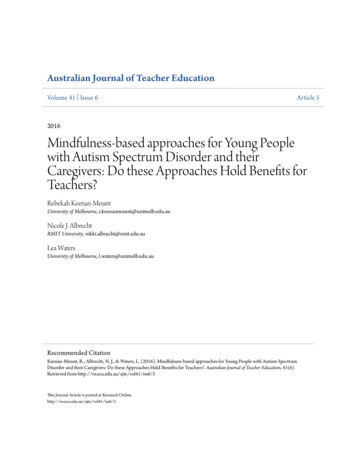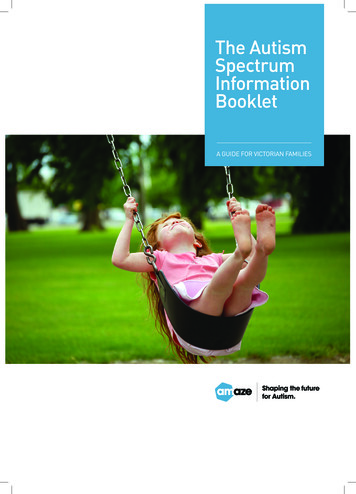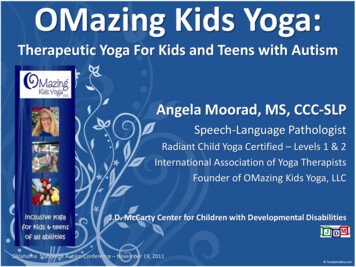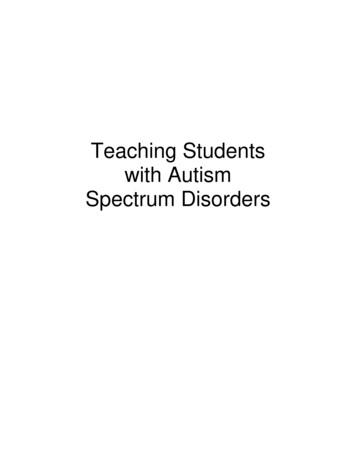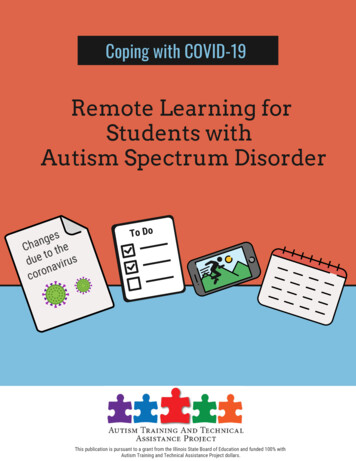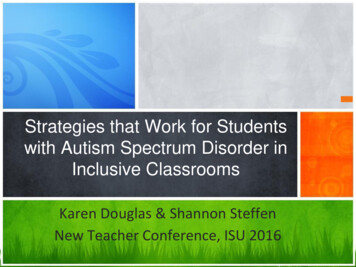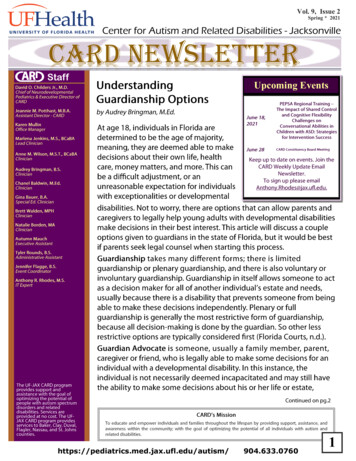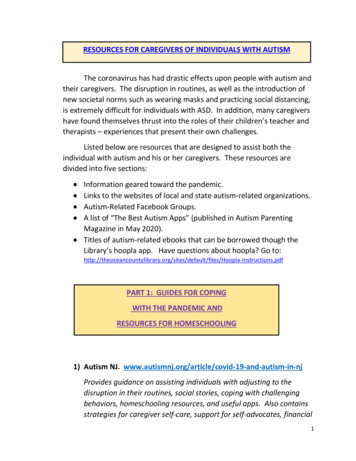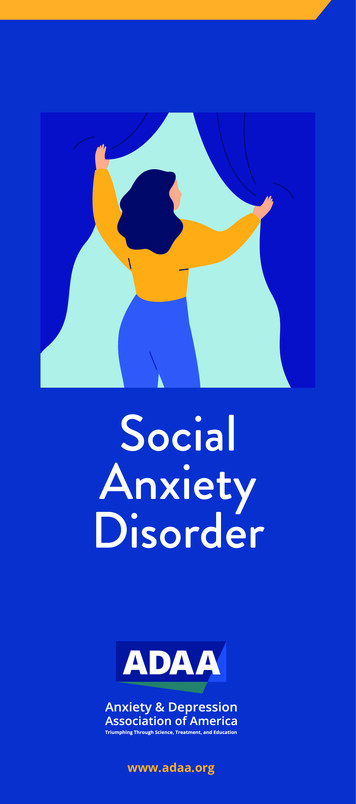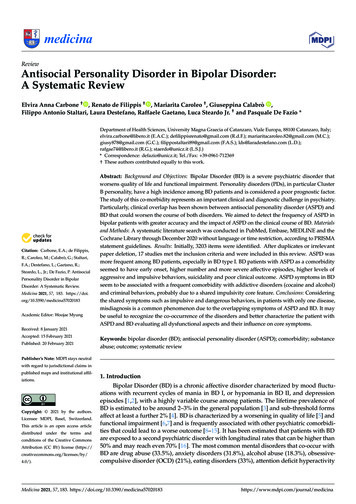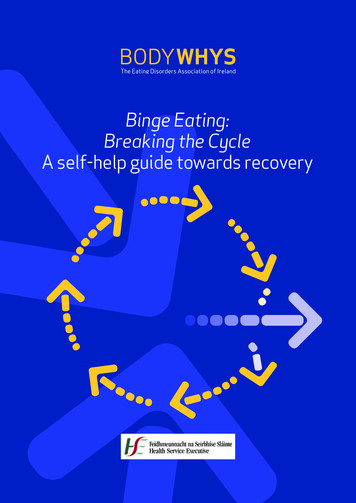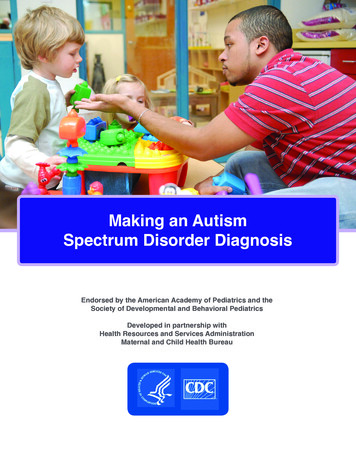
Transcription
Making an AutismSpectrum Disorder DiagnosisEndorsed by the American Academy of Pediatrics and theSociety of Developmental and Behavioral PediatricsDeveloped in partnership withHealth Resources and Services AdministrationMaternal and Child Health Bureau
Making an Autism Spectrum Disorder DiagnosisAbstractBilly is a 3½-year-old boy whose mother brings him to see you because of concerns about behavior problems athome and in school. After listening to the mother’s concerns, observing Billy in your office, and reviewing his history,you refer Billy for a comprehensive evaluation for autism spectrum disorder (ASD). You follow up with Billy’s motherand with specialists involved in his evaluation to ensure the process is completed and to learn the results.Case GoalThe diagnosis of autism spectrum disorder (ASD) is made on the basis of detailed information obtained from thechild’s caregivers, careful observation and assessment of the child, and the use of standardized tools designed to aidin the diagnosis of ASD. After completion of this module, learners will be able to:1. Be familiar with the basic principles regarding the diagnosis and epidemiology of ASD.2. Understand the diagnostic approach to evaluating a child with suspected ASD.Three Steps to Prepare - In 15 Minutes or Less!1Read through the Facilitator’s Guide and make copies of the case and learner worksheet for distribution.2Identify the key topics you wish to address. Consider:3 Knowledge level of learnersAvailable timeYour familiarity with the subjectSelect and prepare the optional teaching tools you wish to use. Each case provides a variety of optionalmaterials to enhance the learning environment, support facilitator style, focus on different themes, oraccommodate different time limitations. These materials are optional for facilitators to use at their discretion. Handouts: select any you wish to use and make copies for distributionPowerPoint: decide if you wish to use and confirm necessary technical equipmentVideo: review embedded video and video library, decide if you wish to use, confirm necessary technicalequipment, and conduct test runThe following case was developed by the authors. Itdoes not necessarily reflect the views or policies of theDepartment of Health and Human Services (HHS) or theCenters for Disease Control and Prevention (CDC).Developed in partnership withHealth Resources and Services AdministrationMaternal and Child Health Bureau.Autism Case Training:A Developmental-Behavioral Pediatrics Curriculum1
Making an Autism Spectrum Disorder DiagnosisKey Learning Objectives of This Case1.2.Be familiar with the basic principles regarding the diagnosis and epidemiology of ASD.a.Describe the two primary areas of impairment in ASD and the severity rating system. (Prompt 3.3 andHandout IV: DSM-5 Diagnostic Criteria for ASD)b.Know the currently reported estimate of the prevalence of ASD in the U.S. (Prompt 4.1)c.Describe the current evidence for the genetic etiology of ASD. (Prompts 4.2 and 4.3)Understand the diagnostic approach to evaluating a child with a suspected ASD.a.Identify the important elements of a comprehensive history. (Prompts 1.1 and 1.2)b.Recognize the important features to assess when observing a child’s behavior.c.List the aspects of the physical exam that are of particular importance when evaluating for ASD.(Prompt 1.4)d.Describe the components of a comprehensive diagnostic evaluation for ASD. (Prompt 3.1 and Handout I:Components of a Comprehensive Evaluation for ASD)Only Have 30 Minutes to Teach? :30Focus your discussion on principles of diagnosis and the diagnostic approach. Use: Handout I: Components of a Comprehensive Evaluation for ASD and Handout IV: DSM-5 DiagnosticCriteria for ASDPotential Prompts: 1.1, 1.4, 3.1, and 3.3Materials Provided Case Worksheet for LearnersThe Case Study: Part I, II, III, IV, V (available in Facilitator’s Guide and on CD)Optional Teaching Tools- PowerPoint with Embedded Videos (available on CD)- Handouts (available in Facilitator’s Guide and on CD) Handout I: Components of a Comprehensive Evaluation for ASD Handout II: Differential Diagnosis of Autism Spectrum Disorder Handout III: AAP screening guidelines Handout IV: DSM-5 ASD Checklist Handout V: Fragile X Syndrome Fact Sheet- Video Library (available on CD)ReferencesCase AuthorsKimberly Macferran, MD, University of Arkansas for Medical SciencesNili Major, MD, Albert Einstein College of Medicine, Children’s Hospital Montefiore: Yale University School of MedicineJill J. Fussell, MD, University of Arkansas for Medical SciencesPamela High, MD, Warren Alpert Medical School of Brown UniversityEditorsGeorgia Peacock, MD, MPH, National Center on Birth Defects and Developmental Disabilities, Centers for Disease Control and PreventionCarol Weitzman, MD, Yale University School of MedicineCatherine Rice, PhD, National Center on Birth Defects and Developmental Disabilities, Centers for Disease Control and PreventionJana Thomas, MPA, Porter NovelliWendy Ruben, MS, Porter NovelliJulia Whitney, Carter Consulting, Inc., National Center on Birth Defects and Developmental Disabilities, Centers for Disease Control and PreventionAutism Case Training:A Developmental-Behavioral Pediatrics Curriculum2
Making an Autism Spectrum Disorder DiagnosisGetting StartedThis case is designed to be an interactive discussion of a scenario residents may encounter in their practice.Participation and discussion are essential to a complete learning experience. This Facilitator’s Guide providespotential prompts, suggestions for directing the discussion, and ideas for incorporating the optional teaching tools. Itis not designed as a lecture.Case study icons:Making an Autism Spectrum Disorder DiagnosisDistribute CaseStudy Part ICase Study Part ICall-out: step-by-step teaching instructionsNote: tips and clarificationSlide: optional slide, if using PowerPointFilmstrip: optional slide contains an embedded videoBilly is a 3 ½ -year-old boy you are seeing for the first time in your resident practice. Hewas born full term following a normal pregnancy and delivery. His newborn screen andneonatal hearing test were normal. At 18 months, he underwent bilateral myringotomytube placement following repeated bouts of otitis media. His mother also had concernsthat he was not speaking any words, and his doctor said, “Let’s wait and see.” Afollow-up appointment was scheduled for when he turned 2. At his 2-year well-childcheck, because of the history of global developmental delay, he was referred to earlyintervention (EI) services.Slide 3Three months ago, Billy began attending a specialized preschool in the local schooldistrict; there, he receives speech, physical, and occupational therapies. This is thethird preschool Billy has attended. He was asked to leave his previous schools becauseof behavioral problems. Billy’s mother reports that his current preschool teacherrecommended that she take him to the pediatrician given concerns about his behavior.Since he began preschool, his teachers have reported that he is extremely hyperactive,does not follow directions, and largely ignores the children in the class.Billy’s mother reports that he has been in good health recently. She tells you that allof his milestones were delayed, particularly his language. She denies any history ofdevelopmental regression. She adds that Billy has made some nice progress since hebegan receiving EI services. He will now use single words like “juice” and “cookie” tomake requests. At home, Billy is a “handful,” but he will usually calm down when sheturns on his favorite cartoon. She describes him as a sweet and loving boy, but shealso shares that he will have prolonged tantrums when denied what he wants and thattantrums will often occur when they are attempting to leave their house. During thesetantrums, he will frequently bang his head and bite his hand, which frightens her. Forsome time now she has been concerned that Billy does not like to play with his similaraged cousins during family get-togethers, but she thought this was because he wasan only child and didn’t like to share. She had been eagerly awaiting his first day ofpreschool so that he could spend more time around other children.When asked about family history, Billy’s mother reports that her sister’s 7-year-old sonis in special education, but she is not sure what kind of evaluation has been done asher sister “does not like to talk about these kinds of things.” She mentions that it hasbeen hard for the family, and she finds Billy’s preschool reports to be embarrassing anddiscouraging. She is frustrated and wants the best for Billy.Paper: potential place to distribute an optional handout:30Digital clock: tips if you only have ‘30 Minutes to Teach’4Autism Case Training:A Developmental-Behavioral Pediatrics CurriculumWhy is This Case Important?It is important for parents to understand that there is no specific lab test or procedure todiagnose ASD. Rather, the diagnosis is made on the basis of detailed information obtainedfrom the child’s caregivers, careful observation of the child, and the use of standardized toolsspecifically designed to help diagnose ASD. The diagnosis may be made by a clinician who hasexpertise in the diagnosis of ASD or by a team of specialists that may include developmentalbehavioral pediatricians, child neurologists, child psychiatrists, psychologists, speech-languagepathologists, occupational or physical therapists, educators, and social workers.Cultural CompetenceIt is important for clinicians to understand how different childrearing practices and culturalnorms may influence key decisions that parents make regarding their child, including obtainingevaluations and treatment, future planning, and acceptance of the child’s diagnosis. Clinicianscan approach parents openly and honestly by asking them about their unique style ofparenting and how the information or recommendations provided are received.Introduce thesession goaland format ofthe case studySlide 1-2See the curriculum introduction for additional information on cultural competence and potentialdiscussion questions.Autism Case Training:A Developmental-Behavioral Pediatrics Curriculum3
Making an Autism Spectrum Disorder DiagnosisCase Study Part IBilly is a 3 ½ -year-old boy you are seeing for the first time in your resident practice. Hewas born full term following a normal pregnancy and delivery. His newborn screen andneonatal hearing test were normal. At 18 months, he underwent bilateral myringotomytube placement following repeated bouts of otitis media. His mother also had concernsthat he was not speaking any words, and his doctor said, “Let’s wait and see.” Afollow-up appointment was scheduled for when he turned 2. At his 2-year well-childcheck, because of the history of global developmental delay, he was referred to earlyintervention (EI) services.Distribute CaseStudy Part ISlide 3Three months ago, Billy began attending a specialized preschool in the local schooldistrict; there, he receives speech, physical, and occupational therapies. This is thethird preschool Billy has attended. He was asked to leave his previous schools becauseof behavioral problems. Billy’s mother reports that his current preschool teacherrecommended that she take him to the pediatrician given concerns about his behavior.Since he began preschool, his teachers have reported that he is extremely hyperactive,does not follow directions, and largely ignores the children in the class.Billy’s mother reports that he has been in good health recently. She tells you that allof his milestones were delayed, particularly his language. She denies any history ofdevelopmental regression. She adds that Billy has made some nice progress since hebegan receiving EI services. He will now use single words like “juice” and “cookie” tomake requests. At home, Billy is a “handful,” but he will usually calm down when sheturns on his favorite cartoon. She describes him as a sweet and loving boy, but shealso shares that he will have prolonged tantrums when denied what he wants and thattantrums will often occur when they are attempting to leave their house. During thesetantrums, he will frequently bang his head and bite his hand, which frightens her. Forsome time now she has been concerned that Billy does not like to play with his similaraged cousins during family get-togethers, but she thought this was because he wasan only child and didn’t like to share. She had been eagerly awaiting his first day ofpreschool so that he could spend more time around other children.When asked about family history, Billy’s mother reports that her sister’s 7-year-old sonis in special education, but she is not sure what kind of evaluation has been done asher sister “does not like to talk about these kinds of things.” She mentions that it hasbeen hard for the family, and she finds Billy’s preschool reports to be embarrassing anddiscouraging. She is frustrated and wants the best for Billy.Autism Case Training:A Developmental-Behavioral Pediatrics Curriculum4
Making an Autism Spectrum Disorder DiagnosisCase Study Part I: Discussion QuestionSlide 4After reading the case, ask participants, “What stands out to you about this case?Case Study Part I: Potential Prompts1.1What important information have you learned from this introduction?1.2What else do you want to know?1.3What is your differential diagnosis at this point?1.4What kinds of things should you look for on observation and physical exam?1.5What type of screening should have occurred at Billy’s 18-month exam?:30:30Follow up withstudent responsesto encourage morediscussion: What in the casesupports that? Why do youthink that? What makes yousay that?Supporting Information for Potential Prompts1.1What important information have you learned from this introduction? :30History of attainment of milestones- H istory of global developmental delay (delay in multiple developmental domains),particularly language delay- No history of regressionHistory of behavior problems- Hyperactive- Does not follow directions- Has extreme tantrums that often include self-injurious behaviors - Has difficulty with transitionsPossible social-communicative concerns- Does not play with other children at schoolPossible medical causes/contributors to current functioningI. Components of aComprehensive Evaluationfor ASD- Normal newborn screen; passed newborn hearing screen- History of recurrent otitis mediaRelevant family history- Male cousin in special educationResponse to interventionHas made improvements since starting early interventionAutism Case Training:A Developmental-Behavioral Pediatrics Curriculum5
Making an Autism Spectrum Disorder Diagnosis1.2What else do you want to know? 1.3Has he had his hearing tested after the newborn screen?How does he let you know what he wants/needs?Does he make eye contact?Does he have joint attention?- Joint attention is shared enjoyment between two people observing an object orevent. The child points to an object, verbalizes, and looks alternatively betweenthe object and the other person to direct their attention to the object of interest.Will he take an object to his parents to show them because he thinks it is interesting or willhe only take them something if he needs help? (Does he have “show-and-tell” behavior?)What is your differential diagnosis at this point? 1.4:30II. Differential Diagnosisof Autism SpectrumDisordersAutism spectrum disorderHearing problemSpeech/language delayCognitive impairment/global developmental delayW hat kinds of things should you look for on observation and physical exam?:30 How does he interact with the examiner? How does he interact with his mother? Does he make eye contact with you? How does he communicate? Does he use single words, phrases, or sentences? 1.5Consider polling theclass to learn opinions ondifferential diagnosisDoes he point at objects in the room? Does he use gestures?Make note of growth parameters, including head circumference.Are there any dysmorphic features?Are there any motor stereotypies, such as hand flapping, toe walking, or otherunusual repetitive behaviors?What type of screening should have occurred at Billy’s 18-month exam? Developmental screeningASD-specific screeningAssessment of family support mechanismsAutism Case Training:A Developmental-Behavioral Pediatrics Curriculum6
Making an Autism Spectrum Disorder DiagnosisCase Study Part I: Discussion QuestionSlide 5Before moving to Part II, ask participants, “What would you do next?”Case Study Part IIAt first, Billy clings to his mother, but as you continue to speak with her, he climbs downfrom her lap and runs around the room touching everything in sight. When you givehim a few toys to play with, he briefly inspects them, smells them, and then throwsthem down. Billy spots a ball in your bag of toys. He points at it and says “ball” withoutlooking at you or his mother. When you toss him the ball, he laughs and makes brief eyecontact with you, but then proceeds to kick and chase the ball around the room, ignoringyour efforts to engage him in play. You call his name several times and he doesn’tanswer. When his mother begins to undress him for the exam, he begins to screamand jump up and down while flapping his hands. She says he tends to have difficultytransitioning from one activity to another. On physical examination, Billy is at the 75thpercentile for weight and height, and his head circumference is at the 98th percentile.His ears are prominent, and he has a wide nasal bridge. He has mildly hyperextensiblejoints. The remainder of his exam is within normal limits.Case Study Part II: Discussion QuestionDistribute “CaseStudy Part II”Slide 6Slide 7 Has your opinion changed with this new information?Case Study Part II: Potential Prompts2.1What do you think about Billy’s behavior in your office?2.2What next steps should be taken?2.3What will you tell Billy’s mother?2.4What are the strengths of this child and family?Autism Case Training:A Developmental-Behavioral Pediatrics Curriculum7
Making an Autism Spectrum Disorder DiagnosisSupporting Information for Potential Prompts2.1What do you think about Billy’s behavior in your office? Does the fact that Billy clings to his mother exclude a diagnosis of ASD?- J oint attention is shared enjoyment between two people observing an object ofevent. The child points to an object, verbalizes, and looks alternatively between theobject and the other person to direct their attention to the object of interest.Note the level of activityNote that he smelled several objects.- This behavior might suggest sensory preoccupation or sensitivities.Billy pointed to a ball. Does the fact that he pointed mean that he does not have ASD?- B illy did point to the ball as he named it. However, there was no joint attentioninvolved with the point. He did not look at his mother to see her response as hereferenced the ball.Billy makes brief eye contact with you. Does this make a diagnosis of ASD more orless likely?- Children with ASD may not have a complete lack of a particular skill. 2.2- M aking brief eye contact only once during the entire office visit would be consideredmarked impairment.What do you think about Billy’s behavior when his mother took off his clothes?What next steps should be taken?In this case, there were both parental and physician concerns. This goes directly to “Step8” of the algorithm: III. AAP ScreeningGuidelinesProvide parental educationSimultaneously refer for:- Comprehensive ASD evaluation- Early intervention/early childhood education services, if not already enrolled 2.3- Audiologic evaluationSchedule a follow-up visitWhat “red flags” indicate immediate need for further assessment? (PracticeParameter from the American Academy of Neurology)No babbling or pointing or other gesture by 12 monthsNo single words by 16 monthsNo two-word spontaneous (not echolalic) phrases by 24 monthsLoss of language or social skills at any ageNote: Billy is older. However, it might be helpful to ask about these when taking a history.What will you tell Billy’s mother? When you are discussing your concerns with a family, it is often helpful to give specificexamples of your concerns (e.g., poor eye contact, lack of joint attention). It is alsoAutism Case Training:A Developmental-Behavioral Pediatrics Curriculum8
Making an Autism Spectrum Disorder Diagnosis important to emphasize good skills that the child is exhibiting (e.g., Billy seems to bevery attached to you. I’m glad to hear that he has been making progress since hestarted therapy.)Explain the importance of further evaluation and arriving at a diagnosis. It is also importantto acknowledge the parents’ worries. Many parents do not want their child to be “labeled”and may be hesitant to have a diagnosis given. Explain that having a specific diagnosishelps ensure that their child will receive appropriate therapies and interventions.It is important to refer the child for early intervention services as soon as ASD or otherdevelopmental disability is suspected. Educate the family on the importance andbenefits of starting therapy as early as possible without creating undue panic or alarm.Find out what the family knows about ASD. It is usually helpful to explain that ASDis a spectrum and that no two children will have exactly the same characteristics.Each child will have his or her own individual strengths and weaknesses and a childmay need more support in some areas than others.Give the family literature on ASD and direct them to resources available in the area.Answer any questions the family may have and be available if they have questionsin the future.Emphasize that children with ASD do continue to have warm relationships. It isimportant for families to have a balance of reality and optimism.See the “Communicating Abnormal Results from a Screening Tool” module for moredetailed information.2.4What are the strengths of this child and family?It is always important to explore the strengths of a child with autism spectrum disorderor developmental delays. Parents and clinicians may become so focused on the deficitsand in some cases the behavioral issues that a child is having, that they aren’t able tonotice what the child does well. By asking a family about what a child is good at, andwhat their positive traits are, one is able to frame recommendations for intervention andtreatment in the context of these strengths. In addition, asking about what a child likescan be used when discussing next steps. Finally, in addition to exploring the strengthsof the child, it is helpful to think about the strengths of the family and how these can beused when discussing options and next steps for treatment. If parents are unable to offerstrengths and positive attributes of the child, it is important to acknowledge how difficultand stressful things seem for them at this time. It is always helpful for clinicians to takethe time to note changes and improvements in functioning and positive features of thechild and narrate these observations to parents. The child has made progress since he began to receive EI services.He is beginning to use language functionally.He is described by his mother as a sweet and loving boy.He is pairing language and gesture when he points to the ball and vocalizes.He displays some capacity for shared pleasure when the examiner throws him theball and he laughs and briefly makes eye contact.Autism Case Training:A Developmental-Behavioral Pediatrics Curriculum9
Making an Autism Spectrum Disorder DiagnosisCase Study Part III ou share your concerns about the things Billy’s mother has told you and about whatYyou have observed during the visit. You tell her that Billy shows some characteristicsof a child with autism spectrum disorder. He exhibits decreased eye contact, lackof joint attention, hand flapping, resistance to transitions, and atypical exploration ofobjects. You recommend she take Billy for additional evaluations. Together, you agreeto proceed with a referral for a multidisciplinary evaluation for the presence of autismspectrum disorder, including an audiologic assessment. You ask Billy’s mother to returnfor a follow-up appointment to ensure the evaluation is proceeding as it should.Case Study Part III: Discussion QuestionDistribute CaseStudy Part IIISlide 8Slide 9What would you do next?Case Study Part III: Potential Prompts3.1What are the usual components of a diagnostic evaluation for ASD?3.2What is the medical/genetic workup for a child with a suspected ASD?3.3What are the DSM-5 criteria for autism spectrum disorder?:30:30Supporting Information for Potential Prompts3.1What are the usual components of a diagnostic evaluation for ASD?:30 A positive screening result does not mean that a child has been diagnosed withASD. In the case of a positive screening test, or when two risk factors are identifiedon surveillance (see “AAP Surveillance and Screening Algorithm: Autism SpectrumDisorders”) the child should be referred for a comprehensive ASD evaluation.Simultaneously, the child should be scheduled for complete audiologic testing (ifnot recently performed) and referred to early intervention/early childhood educationto prevent a delay in receipt of services, if indicated. Pediatricians should becomefamiliar with ASD evaluation sites and specialists in their community. The evaluationmay be performed by a clinician with expertise in the diagnosis of ASD, or by ateam of specialists that may include developmental-behavioral pediatricians, childneurologists, child psychiatrists, psychologists, speech and language pathologists,occupational or physical therapists, educators, and social workers. According to the AAP clinical report “Identification and Evaluation of Children withAutism Spectrum Disorders,” a comprehensive evaluation for the presence of ASDAutism Case Training:A Developmental-Behavioral Pediatrics Curriculum10
Making an Autism Spectrum Disorder Diagnosis should accomplish the following three goals: 1) determine the child’s overall level offunctioning, 2) make a diagnosis of ASD, and 3) attempt to determine the etiology ofthe ASD. To that end, the evaluation should include the following components:Detailed history from primary caregiver, addressing the following:- M edical history – significant pre- and perinatal problems, medical issues,surgeries or hospitalizations, seizures, ear infections- D evelopmental history – language, social, and motor milestones; history of anydevelopmental regression; current communication abilities- Behavioral history – current behavior, socialization, odd or stereotypicalbehaviors, play interests - F amily history – ASD, language disorders, intellectual disabilities, learningdisabilities, ADHD, depression, schizophrenia or other mental illnesses, obsessivecompulsive disorder, genetic disordersPhysical examination – general examination, growth parameters including headcircumference, neurological exam, skin examination, search for dysmorphic featuresDevelopmental and/or psychometric evaluation – assessment of functioningacross all developmental domains. Common tests in use (depending on child’s ageand abilities) that may be performed by a variety of specialists in an interdisciplinaryteam include:- Cognitive Bayley Scales of Infant Development Mullen Scales of Early Learning Wechsler Preschool and Primary Test of Intelligence Wechsler Intelligence Scale for Children Stanford-Binet Intelligence Scales- Speech and Communication Preschool Language Scale MacArthur Communicative Development Inventory- Motor Peabody Developmental Motor Scales Gross Motor Scale- Adaptive Vineland Adaptive Behavior ScalesSensory profileDetermination of the presence of an ASD diagnosis, preferably with standardizedtools that operationalize the DSM criteria. Clinical expertise with review of the DSM5 criteria must be used to interpret the results of the objective tests. Commonlyused tools include the following:- Autism Diagnostic Observation Schedule (ADOS-2) – The examinerobserves the child through a series of structured and semi-structured scenarios,and rates the child based on his or her social interaction, communication, andstereotyped behaviors. The module to be administered is selected according tothe child’s verbal ability.- Autism Diagnostic Interview-Revised (ADI-R) – This is a comprehensive,structured interview administered by a trained clinical interviewer to theAutism Case Training:A Developmental-Behavioral Pediatrics Curriculum11
Making an Autism Spectrum Disorder Diagnosisparent or caregiver. It includes 92 questions about the child’s language andcommunication, social interaction, and behavior/interests. The ADOS-2 and ADI-R both require extensive training and clinicalexpertise.- Other tools may include the Childhood Autism Rating Scale (CARS-2)and Gilliam Autism Rating Scale (GARS-2). These tools are often used inconjunction with other clinical assessment tools to support diagnosis. CARS-2 is a 15-item scale that assesses for clinical symptoms of autism. Itis completed by the examiner based on obtained history and observation.Resulting scores are categorized as “no autism,” “mild to moderate autism,”or “severe autism.” GARS-2 is a 42-item rating scale assessing symptoms of autism based onfrequency of occurrence. It can be completed by parents or professionals. 3.2Assessment of parents’ knowledge of ASD, coping skills, and available resourcesand supports.A laboratory investigation to search for a known etiology or co-existing condition.(See question 3.2 for more information).What is the medical/genetic workup for a child with suspected ASD?There is no laboratory or radiologic test that will diagnose ASD. Instead, medicalevaluations can aid in ruling in or out other medical disorders on the differential, oronce a diagnosis of ASD is made, searching for a known etiology or determining thepresenc
The diagnosis may be made by a clinician who has expertise in the diagnosis of ASD or by a team of specialists that may include developmental-behavioral pediatricians, child neurologists, child psychiatrists, psychologists, speech-language pathologists, occupational or physical therapists,
